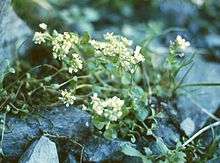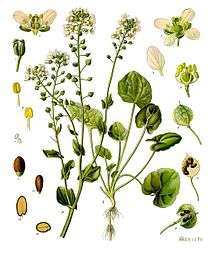Cochlearia
Cochlearia (scurvy-grass or spoonwort) is a genus of about 30 species of annual and perennial herbs in the family Brassicaceae. They are widely distributed in temperate and arctic areas of the northern hemisphere, most commonly found in coastal regions, on cliff-tops and salt marshes where their high tolerance of salt enables them to avoid competition from larger, but less salt-tolerant plants; they also occur in alpine habitats in mountains and tundra.
- The unrelated scurvy-grass sorrel (Oxalis enneaphylla) is sometimes simply called "scurvygrass".
- For the Roman era spoons see Cochlearia (spoon)
| Scurvy-grass | |
|---|---|
 | |
| Cochlearia officinalis subsp. pyrenaica | |
| Scientific classification | |
| Kingdom: | Plantae |
| Clade: | Tracheophytes |
| Clade: | Angiosperms |
| Clade: | Eudicots |
| Clade: | Rosids |
| Order: | Brassicales |
| Family: | Brassicaceae |
| Genus: | Cochlearia L. |
| Species | |
|
About 25 species, see text | |
They form low, rounded or creeping plants, typically 5–20 cm tall. The leaves are smoothly rounded, roughly spoon-shaped (the scientific name Cochlearia derives from the Latinized form, cocleare, of the Greek κοχλιάριον, kokhliárion, a spoon; this a diminutive of κόχλος, kókhlos, seashell), or in some species, lobed; typically 1–5 cm long, and with a fleshy texture. The flowers are white with four petals and are borne in short racemes.
Selected species
About 30 species are usually accepted; several others usually treated as subspecies of C. officinalis are accepted as distinct species by some botanists.
- Cochlearia acutangula
- Cochlearia aestuaria – Estuarine scurvy-grass
- Cochlearia alatipes
- Cochlearia anglica – English scurvy-grass
- Cochlearia aragonensis
- Cochlearia changhuaensis
- Cochlearia cyclocarpa – Roundfruit scurvy-grass
- Cochlearia danica – Early or Danish scurvy-grass
- Cochlearia fenestrata – Arctic scurvy-grass
- Cochlearia formosana
- Cochlearia excelsa
- Cochlearia fumarioides
- Cochlearia furcatopilosa
- Cochlearia glastifolia
- Cochlearia groenlandica – Greenland scurvy-grass
- Cochlearia henryi
- Cochlearia hui
- Cochlearia lichuanensis
- Cochlearia longistyla
- Cochlearia megalosperma
- Cochlearia microcarpa
- Cochlearia oblongifolia – East Asian scurvy-grass
- Cochlearia officinalis – Common scurvy-grass (including C. excelsa, C. pyrenaica, C. scotica)[1]
- Cochlearia paradoxa
- Cochlearia rivulorum
- Cochlearia rupicola
- Cochlearia sessilifolia – Sessile-leaved or Alaskan scurvy-grass
- Cochlearia sinuata
- Cochlearia tatrae
- Cochlearia tridactylites – Three-fingered scurvy-grass
- Cochlearia warburgii
Two species formerly included in the genus Cochlearia are now usually treated in separate genera:
- Horseradish Armoracia rusticana (previously Cochlearia armoracia)
- Wasabi Wasabia japonica (previously Cochlearia wasabi)
Cook's scurvy grass, Lepidium oleraceum, was used by James Cook to prevent scurvy, but is now almost extinct.
History and uses
In the first century A.D. Pliny the Elder (A.D. 23-79) writes in his Naturalis Historia (Natural History), about a disease suffered by Roman soldiers in Germany. Their symptoms resemble those of scurvy, and Pliny recommends a Herba britannica, which has been suggested to be scurvy-grass.[2][3]
Scurvy-grass was frequently eaten in the past by sailors suffering from scurvy after returning from long voyages.[4][5] The leaves are rich in vitamin C,[6][3] which cures this deficiency disease resulting from a lack of fresh vegetables in the diet.[7]
The Rev. George Moore recorded the purchase of "a pint of scurvey-grasse" for 1 s in 1662. He apparently "suffered much" from scurvy, purchasing scurvey-grasse in both bundled and bottled form.[5] The book Cochlearia curiosa: or the curiosities of scurvygrass was published in English in 1676,[8] Described as "both a learned and accurate work", it was well received.[9] and apparently brought scurvy-grass "into great repute" as a remedy.[5] The book contained "not only a description of the several kinds of this plant, with its several names, place, and time of growth, temperature and general vertues, but also an enumeration of the uses, medicinal vertues and manner of applying each part of this plant."[10] In 1857, Cochlearia officinalis was described in The Elements of Materia Medica and Therapeutics as "A gentle stimulant, aperient, and diuretic. It has long been esteemed as an antiscorbutic. It has also been used in visceral obstructions. It is occasionally eaten with bread and butter, like the water-cress."[11]
The leaves, which have a strong acrid, bitter, or peppery taste similar to the related horseradish and watercress, are also sometimes used in salads or eaten with bread and butter.[11]
Scurvy-grass sorrel (Oxalis enneaphylla) is an unrelated plant from southern South America and the Falkland Islands that was also used to treat scurvy.
Scurvy-grass and roads
The advent of modern fast roads treated with salt in winter for ice clearance has resulted in the colonisation by scurvy-grass of many inland areas where it formerly did not occur. The scurvy-grass seeds become trapped on car wheels, transported often for a considerable distance, and then washed off, to grow in the salt-rich soil at the side of the road where other plants cannot survive.[12]
 Cochlearia officinalis on Bear Island, Norway
Cochlearia officinalis on Bear Island, Norway 19th century illustration of Cochlearia officinalis
19th century illustration of Cochlearia officinalis "Scurvy-grass" from The Book of Health, 1898, by Henry Munson Lyman
"Scurvy-grass" from The Book of Health, 1898, by Henry Munson Lyman
References
- "Cochlearia officinalis Scurvy Grass, Spoonwort PFAF Plant Database". pfaf.org. Retrieved 14 September 2015.
- Klenner, F.; Stone, Irwin; Cathcart, Robert (2018). 80 Years of High-Dose-Vitamin C Research. Books on Demand. p. 359. ISBN 978-3-7528-1275-6. Retrieved 13 May 2018.
- Brickley, Megan; Ives, Rachel (2008). The Bioarchaeology of Metabolic Bone Disease. Burlington: Elsevier. pp. 41–44. ISBN 9780080557915. Retrieved 13 May 2018.
- "Discover the Heritage of the Tees". Gazette Live. 22 November 2006. Retrieved 21 June 2017.
- Blencowe, Robert Willis (1848). "Extracts from the Journal and Account Book of the Rev. Giles Moore". Sussex Archaeological Collections. 1. London: Sussex Archaeological Society; John Russell Smith. p. 87. Retrieved 13 May 2018.
- Packer, Lester; Fuchs, Jürgen (1997). Vitamin C in health and disease. New York: M. Dekker. pp. 11–17. ISBN 978-0824793135. Retrieved 13 May 2018.
- Price, Catherine (2017). "The Age of Scurvy". Distillations. 3 (2): 12–23. Retrieved May 13, 2018.
- Moellenbrock, Valentin Andreas; Sherley, Thomas (1675). Cochlearia curiosa: or The curiosities of scurvygrass. Being an exact scrutiny and careful description of the nature and medicinal vertue of scurvygrass. In which is exhibited to publick use the most and best preparations of medicines, both Galenical and chymical; either for internal or external use, in which that plant, or any part thereof is imployed. Written in Latine by Dr. Andreas Valentinus Molimbrochius of Lipswick. Englished by Tho. Sherley, M.D. and physitian in ordinary to His present Majesty. London: Printed by S. and B. Griffin for William Cademan. Retrieved 2 November 2018.
- Kenny, Neil (2004). The uses of curiosity in early modern France and Germany. Oxford [u.a.]: Oxford Univ. Press. p. 190. ISBN 9780199271368. Retrieved 13 May 2018.
- "An Accompt of Some Books". Philosophical Transactions of the Royal Society of London. 11 (123–132): 621. 1 January 1676. doi:10.1098/rstl.1676.0015. Retrieved 13 May 2018.
- Pereira, Jonathan; Kilmer, Fred B. (1857). The Elements of Materia Medica and Therapeutics. 2. Longman, Brown, Green, and Longmans. p. 579. ISBN 9781278610887. Retrieved 13 May 2018.
- "The Use of Old Records - Some Worked Examples". wbrc.org.uk. Retrieved 14 September 2015.